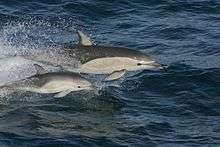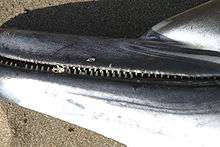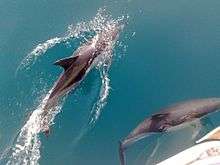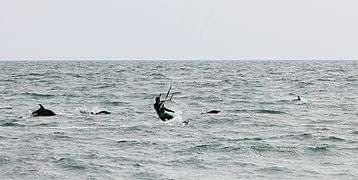Short-beaked common dolphin
| Short-beaked common dolphin[1] | |
|---|---|
 | |
| Scientific classification | |
| Kingdom: | Animalia |
| Phylum: | Chordata |
| Clade: | Synapsida |
| Class: | Mammalia |
| Order: | Artiodactyla |
| Infraorder: | Cetacea |
| Family: | Delphinidae |
| Genus: | Delphinus |
| Species: | D. delphis |
| Binomial name | |
| Delphinus delphis Linnaeus, 1758 | |
| Subspecies | |
| |
| | |
| Short-beaked Common Dolphin range | |
| Synonyms[3] | |
| |
The short-beaked common dolphin (Delphinus delphis) is a species of common dolphin. It has a larger range than the long-beaked common dolphin (D. capensis), occurring throughout warm-temperate and tropical oceans, including the Indian Ocean although in smaller quantities than other places they are found.[4] There are more short-beaked common dolphins than any other dolphin species in the warm-temperate portions of the Atlantic and Pacific Oceans.[5] It is also found in the Caribbean and Mediterranean Seas. The short-beaked common dolphin is also abundant in the Black Sea, Gulf of Mexico, and Red Sea. They follow the gulf stream up to Norwegian waters. Seldom do any short-beaked dolphin venture near the Arctic.[4]
Physical characteristics

The short-beaked common dolphin is a medium-sized dolphin, smaller than the more widely known bottlenose dolphin. Adults vary in length from five to eight feet and range in mass from 100 to 136 kilograms or 220.26 to 299 pounds.[4][6] Males are generally longer and heavier,[6] with a sexual size dimorphism of 1.06. Mature males also have prominent postanal humps. The color pattern on the body is unusual. The back is dark and the belly is white, while on each side is an hourglass pattern colored light grey, yellow or gold in front and dirty grey in back.[7] It has a long, thin rostrum with 50–60 small, sharp, interlocking teeth on each side of each jaw.[8] Juvenile dolphins have a more muted appearance and become more distinguishable when they mature.[9]
Taxonomy

The short-beaked common dolphin is a member of common dolphin genus, Delphinus, within the dolphin family, Delphinidae. Until the mid-1990s, the different forms within Delphinus were not recognized as separate species, but were all considered members of the species D. delphis.[5][6] Currently, there are two recognized species of Delphinus: the short-beaked common dolphin and the long-beaked common dolphin (D. capensis).[10] The short-beaked common dolphin is generally smaller than the long-beaked common dolphin and has a shorter rostrum. Differentiation among the short-beaked variety can be attributed to ocean temperature, chlorophyll concentration, and ocean turbidity, rather than zoogeographical distribution.
Behavior

Short-beaked common dolphins can live in aggregations of hundreds or even thousands of dolphins.[5] They sometimes associate with other dolphin species, such as pilot whales.[5] They have also been observed bow riding on baleen whales, and they also bow ride on boats.[5] It is a fast swimmer (over 60 km/h), and breaching behavior and aerial acrobatics are common with this species.[6] They are very social animals and engage in most necessary activities such as traveling, eating, and breathing together.[4] They usually associate in groups that can consist of 1000s to 100,000s of individuals.[11] When some individuals are sick, others in the group assist them by using their fins to help keep them afloat so they survive.[4]
Diet
The short-beaked common dolphin has a varied diet consisting of many species of fish and squid that live less than 200 metres (660 ft) deep.[5] The short-beaked common dolphin has been known to eat small fish, such as herring, pilchard, anchovies, hake, sardines, bonito, and sauries, as well as squid and octopus. The diet of short-beaked common dolphins near the English Channel consists mostly of lanternfish, Atlantic mackerel, sprats, and squids. In the Black Sea, their diet contains sprats, anchovies, and pipefish. In the Mid-Atlantic region near the Northeastern United States, their diet contains Atlantic Mackerel.[12] They typically eat anywhere from 18 to 20 pounds a day.[4]
In order to study the long-term diet of short-beak common dolphins, their intake of Cadmium (Cd) was observed in 2004. In oceanic regions short-beaked dolphins diet consist largely of Cephalopods (such as Cranchids and Histioteuthids). In coastal areas, their diet contained up to 10 times less cephalopods.[13]
Reproduction

Females tend to reach sexual maturity when they have grown to 85% of their final size. It is at this point that the distribution of resources in their bodies becomes more focused on their sexual organs, rather than their physical size. This is usually when they are approximately 12 to 15 years of age. Like many other animals, female short-beaked common dolphins are considered sexually mature when they have ovulated at least once.[14]
Similar to humans, the short-beaked common dolphin is viviparous. Though they have the ability to carry twins, triplets, etc., they usually only carry one baby at a time.[4] The Short-beaked common dolphin has a gestation period of 10 to 11 months.[5] The newborn calf has a length of between 70 and 100 centimetres (2.3 and 3.3 ft) and weighs about 10 kilograms (22 lb).[6] For the Black Sea population, weaning occurs at between 5 and 6 months, but occurs later (up to about 19 months) in other areas.[5][6] Typical interbirth interval ranges from 1 year for the Black Sea population to 3 years for eastern Pacific Ocean populations.[5] Age of sexual maturity also varies by location, but can range between 2 and 7 years for females and 3 and 12 years for males.[5][6] Common short-beaked dolphins have been observed to engage in oral sex, intimating that they – like chimpanzees and humans – engage in sexual activities for pleasure.[4]
After a baby is born, it immediately becomes part of the family and takes part in daily life. Staying close to its mother, the calf never strays more than a few feet, especially when it is very young. Until the calf is six months old, it obtains its nourishment solely from its mother's milk. Unlike humans, short-beaked common dolphins have no lips and cannot suck on the teats of its mother. If they did have this ability they would drown. Thus, the female dolphin's mammary glands have a muscle that when contracted, squirts milk so that it can feed its calf.[4]
Maximum lifespan is 35 years, but has been estimated at 22 years for the Black Sea population.[5][6]
Habitat

Short-beaked common dolphins are commonly found in warm tropical waters, they are known to live in areas of the Atlantic, Pacific, and Southeast Indian Ocean. They are believed to have originated in the eastern Indo-Pacific Ocean during the Pleistocene and expanded into the Atlantic Ocean through the Indian Ocean due to climate oscillations.[15] Short-beaked common dolphins have been shown to reside in the Gulf of Corinth of the Ionian Sea. They were found in groups of Striped dolphin; their numbers were very small and believed to be unsuitable for survival. Traces of hybridization were found on Striped dolphins, leading further credence to their inability to survive in such groups.[16] The number of short-beaked common dolphins has declined elsewhere in Western Greece, specifically the island of Kalamos. Overfishing has been studied to have reduced the number of available prey for dolphins near the island between 1996 and 2007.[17]
Conservation

The Mediterranean population of the short-beaked common dolphin Delphinus delphis is listed on Appendix I,[18] while the North Sea, Baltic Sea, Mediterranean, Black Sea and eastern tropical Pacific populations are listed on Appendix II[18] of the Convention on the Conservation of Migratory Species of Wild Animals (CMS). The regional listing on Appendix I [18] means that this population has been categorized as being in danger of extinction and CMS Parties strive towards strictly protecting these animals, conserving or restoring the places where they live, mitigating obstacles to migration and controlling other factors that might endanger them. It was listed on Appendix II[18] as it has an unfavourable conservation status or would benefit significantly from international co-operation organised by tailored agreements.
In addition, the species is also covered by the Agreement on the Conservation of Small Cetaceans of the Baltic, North East Atlantic, Irish and North Seas (ASCOBANS)[19] and the Agreement on the Conservation of Cetaceans in the Black Sea, Mediterranean Sea and Contiguous Atlantic Area (ACCOBAMS).[20] The species is further included in the Memorandum of Understanding Concerning the Conservation of the Manatee and Small Cetaceans of Western Africa and Macaronesia[21][22] and the Memorandum of Understanding for the Conservation of Cetaceans and Their Habitats in the Pacific Islands Region (Pacific Cetaceans MoU).[23]
Mass stranding events
On June 8, 2009, a mass-stranding event (MSE) occurred in Falmouth Bay, Cornwall, United Kingdom. It is believed the MSE was likely caused by naval involvement, as all other factors which cause MSEs in cetaceans currently appear unlikely to have influenced the event. During the event, twenty-six common dolphins washed ashore, and about the same amount floated back out to sea. There were three other MSEs in the UK before this event, all of unknown cause, from the years 1915 to 1938, but with arguably lower counts of stranded dolphins.[24]
Bycatch
See Cetacean bycatch
There have been few studies specific to bycatch in relation to the short-beaked common dolphin, however certain models indicate that its effect on the reproduction of the species is greater than expected, and as compared with other species of dolphin.[25] About 1000 short-beaked common dolphins are bycaught in the North Atlantic each year by either tuna drift, trawling and gillnetting. The regulation is that only cetacean bycatch can not be longer than 15 meters [26] and this can lead to be a problem because short-beaked common dolphins are only about 2.7 meters.
See also
References
- ↑ Mead, J.G.; Brownell, R. L. Jr. (2005). "Order Cetacea". In Wilson, D.E.; Reeder, D.M. Mammal Species of the World: A Taxonomic and Geographic Reference (3rd ed.). Johns Hopkins University Press. pp. 723–743. ISBN 978-0-8018-8221-0. OCLC 62265494.
- ↑ Hammond, P.S.; Bearzi, G.; Bjørge, A.; Forney, K.; Karczmarski, L.; Kasuya, T.; Perrin, W.F.; Scott, M.D.; Wang, J.Y.; Wells, R.S.; et al. (2008). "Delphinus delphis". IUCN Red List of Threatened Species. Version 2008. International Union for Conservation of Nature. Retrieved 7 October 2008.
- ↑ Perrin, W. (2009). Delphinus delphis Linnaeus, 1758. In: Perrin, W.F. World Cetacea Database.
- 1 2 3 4 5 6 7 8 9 Alspaugh, M. "Delphinus delphis". Animal Diversity Web. Retrieved 20 October 2013.
- 1 2 3 4 5 6 7 8 9 10 11 Perrin, W. (2002). "Common Dolphins". In Perrin, W.; Wursig, B.; Thewissen, J. Encyclopedia of Marine Mammals. Academic Press. pp. 245–248. ISBN 0-12-551340-2.
- 1 2 3 4 5 6 7 8 Shirihai, H. & Jarrett, B. (2006). Whales, Dolphins and Other Marine Mammals of the World. pp. 171–174. ISBN 0-691-12757-3.
- ↑ Reeves, Stewart; Clapham, Powell. Guide to Marine Mammals of the World. p. 388. ISBN 0-375-41141-0.
- ↑ "The Common Dolphin". Retrieved 2008-07-03.
- ↑ "Short Beaked Dolphin". Retrieved 2013-10-23.
- ↑ Mead, J.G.; Brownell, R. L. Jr. (2005). "Order Cetacea". In Wilson, D.E.; Reeder, D.M. Mammal Species of the World: A Taxonomic and Geographic Reference (3rd ed.). Johns Hopkins University Press. pp. 723–743. ISBN 978-0-8018-8221-0. OCLC 62265494.
- ↑ "Short-Beaked Common Dolphin." Oregon Coast Aquarium. Oregon Coast Aquarium. Web. 22 Oct 2013.
- ↑ Ohizumi, H.; Yoshioka, M.; Mori, K.; Miyazaki, N. (1998). "Stomach Contents of Common Dolphins (Delphinus Delphis) in the Pelagic Western North Pacific". Marine Mammal Science. 14 (4): 835. doi:10.1111/j.1748-7692.1998.tb00767.x.
- ↑ Lahaye, V.; Bustamante, P.; Spitz, J.; Dabin, W.; Das, K.; Pierce, G. J.; Caurant, F. (2005). "Long-term dietary segregation of common dolphins Delphinus delphis in the Bay of Biscay, determined using cadmium as an ecological tracer". Marine Ecology Progress Series. 305: 275. doi:10.3354/meps305275.
- ↑ Danil, Kerri; Chivers, S.J. (2006). "Growth and reproduction of female short-beaked common dolphins, Delphinus delphis, in the eastern tropical Pacifi" (PDF). Canadian Journal of Zoology. 85: 108–121. doi:10.1139/z06-188.
- ↑ Amaral, A. R.; Beheregaray, L. B.; Bilgmann, K.; Freitas, L. S.; Robertson, K. M.; Sequeira, M.; Stockin, K. A.; Coelho, M. M.; Möller, L. M. (2012). "Influences of past climatic changes on historical population structure and demography of a cosmopolitan marine predator, the common dolphin (genus Delphinus)" (PDF). Molecular Ecology. 21 (19): 4854–4871. doi:10.1111/j.1365-294X.2012.05728.x. PMID 22891814.
- ↑ Bearzi, G.; Bonizzoni, S.; Agazzi, S.; Gonzalvo, J.; Currey, R. J. C. (2011). "Striped dolphins and short-beaked common dolphins in the Gulf of Corinth, Greece: Abundance estimates from dorsal fin photographs". Marine Mammal Science. 27 (3): E165. doi:10.1111/j.1748-7692.2010.00448.x.
- ↑ Bearzi, G.; Agazzi, S.; Gonzalvo, J.; Costa, M.; Bonizzoni, S.; Politi, E.; Piroddi, C.; Reeves, R. R. (2008). "Overfishing and the disappearance of short-beaked common dolphins from western Greece". Endangered Species Research. 5: 1. doi:10.3354/esr00103.
- 1 2 3 4 "Appendix I and Appendix II" of the Convention on the Conservation of Migratory Species of Wild Animals (CMS). As amended by the Conference of the Parties in 1985, 1988, 1991, 1994, 1997, 1999, 2002, 2005 and 2008. Effective: 5 March 2009.
- ↑ Agreement on the Conservation of Small Cetaceans of the Baltic, North East Atlantic, Irish and North Seas. Ascobans.org. Retrieved on 2013-12-14.
- ↑ Agreement on the Conservation of Cetaceans in the Black Sea, Mediterranean Sea and Contiguous Atlantic Area. Accobams.org. Retrieved on 2013-12-14.
- ↑ Memorandum of Understanding Concerning the Conservation of the Manatee and Small Cetaceans of Western Africa and Macaronesia. cms.int
- ↑ Convention on Migratory Species page on the Short-beaked common dolphin. cms.int
- ↑ Memorandum of Understanding for the Conservation of Cetaceans and Their Habitats in the Pacific Islands Region. Pacificcetaceans.org. Retrieved on 2013-12-14.
- ↑ Jepson, P. D.; Deaville, R.; Acevedo-Whitehouse, K.; Barnett, J.; Brownlow, A.; Brownell Jr, R. L.; Clare, F. C.; Davison, N.; Law, R. J.; Loveridge, J.; MacGregor, S. K.; Morris, S.; Murphy, S. A.; Penrose, R.; Perkins, M. W.; Pinn, E.; Seibel, H.; Siebert, U.; Sierra, E.; Simpson, V.; Tasker, M. L.; Tregenza, N.; Cunningham, A. A.; Fernández, A. (2013). Fahlman, Andreas, ed. "What Caused the UK's Largest Common Dolphin (Delphinus delphis) Mass Stranding Event?". PLoS ONE. 8 (4): e60953. doi:10.1371/journal.pone.0060953. PMC 3640001
 . PMID 23646103.
. PMID 23646103. - ↑ Mannocci, L.; Dabin, W.; Augeraud-Véron, E.; Dupuy, J. F. O.; Barbraud, C.; Ridoux, V. (2012). Reina, Richard, ed. "Assessing the Impact of Bycatch on Dolphin Populations: The Case of the Common Dolphin in the Eastern North Atlantic". PLoS ONE. 7 (2): e32615. doi:10.1371/journal.pone.0032615. PMC 3290591
 . PMID 22393423.
. PMID 22393423. - ↑ Mannocci, L; Dabin, W; Augeraud-Véron, E; Dupuy, JF; Barbraud, C; Ridoux, V (2012). Reina, Richard, ed. "Assesing the Impact of Bycatch on Dolphin Populations: The Case of the Common Dolphin in the Eastern North Atlantic". PLoS ONE. 7 (2): e32615. doi:10.1371/journal.pone.0032615. PMC 3290591
 . PMID 22393423.
. PMID 22393423.
External links
| Wikimedia Commons has media related to Delphinus delphis. |
| Wikispecies has information related to: Delphinus delphis |
- "Short-beaked common dolphin". National Center for Biotechnology Information (NCBI).
- Short-beaked common dolphin at the Encyclopedia of Life

- Whale and Dolphin Conservation Society
- Voices of the Sea – Sounds of the Short-beaked Common Dolphin
